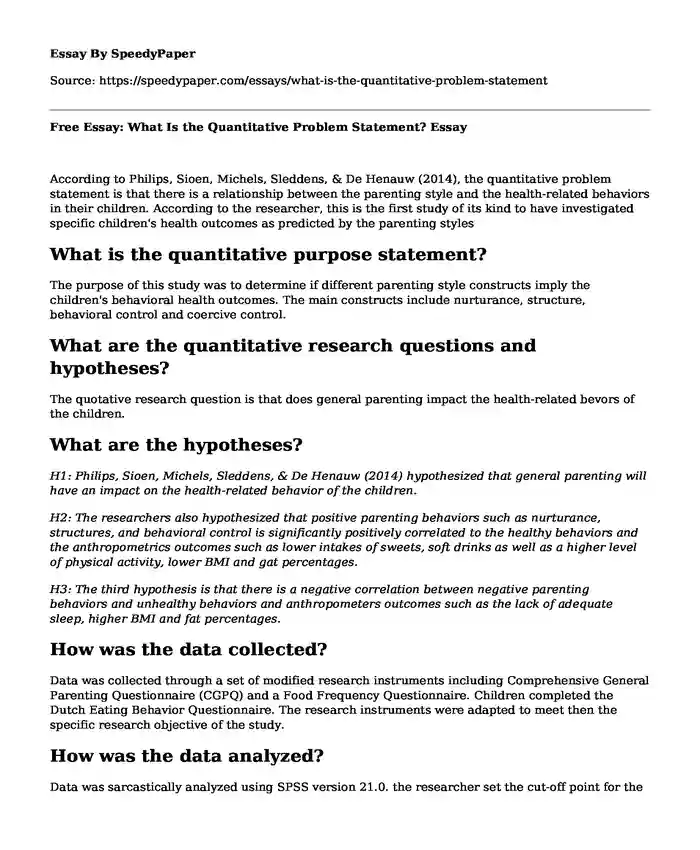
| Type of paper: | Course work |
| Categories: | Research Parenting Child development Human behavior |
| Pages: | 3 |
| Wordcount: | 658 words |
According to Philips, Sioen, Michels, Sleddens, & De Henauw (2014), the quantitative problem statement is that there is a relationship between the parenting style and the health-related behaviors in their children. According to the researcher, this is the first study of its kind to have investigated specific children's health outcomes as predicted by the parenting styles
What is the quantitative purpose statement?
The purpose of this study was to determine if different parenting style constructs imply the children's behavioral health outcomes. The main constructs include nurturance, structure, behavioral control and coercive control.
What are the quantitative research questions and hypotheses?
The quotative research question is that does general parenting impact the health-related bevors of the children.
What are the hypotheses?
H1: Philips, Sioen, Michels, Sleddens, & De Henauw (2014) hypothesized that general parenting will have an impact on the health-related behavior of the children.
H2: The researchers also hypothesized that positive parenting behaviors such as nurturance, structures, and behavioral control is significantly positively correlated to the healthy behaviors and the anthropometrics outcomes such as lower intakes of sweets, soft drinks as well as a higher level of physical activity, lower BMI and gat percentages.
H3: The third hypothesis is that there is a negative correlation between negative parenting behaviors and unhealthy behaviors and anthropometers outcomes such as the lack of adequate sleep, higher BMI and fat percentages.
How was the data collected?
Data was collected through a set of modified research instruments including Comprehensive General Parenting Questionnaire (CGPQ) and a Food Frequency Questionnaire. Children completed the Dutch Eating Behavior Questionnaire. The research instruments were adapted to meet then the specific research objective of the study.
How was the data analyzed?
Data was sarcastically analyzed using SPSS version 21.0. the researcher set the cut-off point for the significance at p < 0. 05. Other tests include ANOVA, t-test, Pearson's correlation test, and multiple linear regression analysis.
What was the benefit of using the selected statistical test?
Philips, Sioen, Michels, Sleddens, & De Henauw (2014) conducted a descriptive statistic to get the means and standard deviation for all the continuous variables, and the frequencies for the categorical variables. The researcher also executed Pearson's correlations to test for relationships among the variables. The researcher also conducted an ANOVA test, t-test, as well as the multiple linear regressions, which were performed to determine the relationship between the parenting constructs and the key variables. The multiple linear regression was useful because it helped in modeling the constructs to determine how the parental constructs would impact the children's health behaviors
What was the outcome of the study?
The researcher found that there was a significant correlation between parental education and parenting constructs such as overprotection and structure. The researcher also found that there was no relationship between parental education and behavioral controls. The highly educated parents tend to be overprotective over their children as compared to the less educated. Additionally, educated parents have more structure than the lower educated parents. Higher education is correlated with more monitoring, control, and restriction. The educated parent wants to produce more and better structure for their children as the parents have a higher awareness of the importance of structure in a child's life. The researcher also found that parents with higher BMI tend to be more controlling and overprotective. Despite this finding contrasting the study done by Wardle et al (2002), it has implications on parenting. Parenting constructs such as structure and behavioral control are negatively correlated to emotional eating. There was however no relationship between the parenting controls and the physical activity which is consistent with the findings of Wardle et al (2002).
References
Philips, N., Sioen, I., Michels, N., Sleddens, E., & De Henauw, S. (2014). The influence of parenting style on health-related behavior of children: Findings from the ChiBS study. International Journal of Behavioral Nutrition & Physical Activity, 11(1), 1-23.
Wardle J, Sanderson S, Guthrie CA, Rapoport L, &, Plomin R. (2002). Parental feeding style andthe intergenerational transmission of obesity risk. Obes Res. 10 (12), 453-462. doi: 10.1038/oby.2002.63.
Cite this page
Free Essay: What Is the Quantitative Problem Statement?. (2023, Apr 24). Retrieved from https://speedypaper.net/essays/what-is-the-quantitative-problem-statement
Request Removal
If you are the original author of this essay and no longer wish to have it published on the SpeedyPaper website, please click below to request its removal:
- Social Media Research Paper: Geo-social Contents. Free Essay.
- Our Mortality - Free Essay Sample
- Creative Writing Essay Example: Products' Ads
- Societies and Ethics, Free Essay Sample for Students
- US History Essay Example on the American Civil War
- Free Essay - Thomas Hobbes and Religion/Politics
- Paper Example. Determining What Organizations to Compare Your Organization
Popular categories




